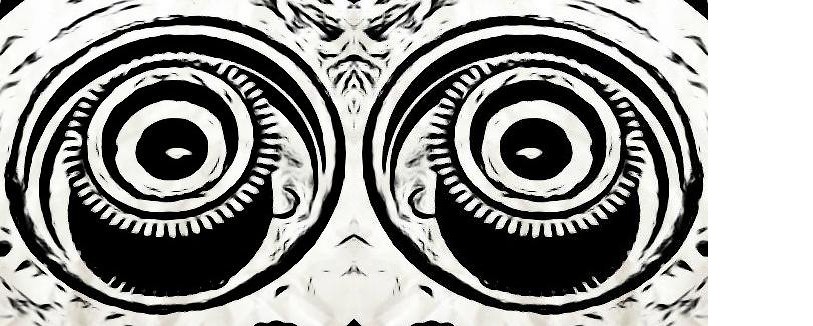According to Michael Leyton, in Symmetry, Causality, Mind (p. 519),
In cubism, Picasso is the first artist to discover that sight is a creative act. Sight is an active exploration and manipulation of objects. Sight constructs the world, and in so doing, is a free agent.
According to R. N. Shakul
And yet, despite filmic narrative techniques (brief scenes, multiple locations, jump cuts, flashbacks, flashbacks within flashbacks, etc) techniques which are also impacting on writing for the stage there is no question but that we still experience even a non-Aristotelian movie or play as a unity. This phenomenon, which would doubtless have set the Greek philosopher scratching his head in perplexity, stems from the fact that the sense of unity does not arise from some set of Aristotelian rules imposed on the play from the outside, but from within ourselves. If we hadn’t known this intuitively, we were persuaded of it by a number of ingenious experiments on visual perception that were carried out by Gestalt psychologists in the 20s and 30s of the last (i.e. twentieth!) century. Unities ‘r’ Us. And this means that the Aristotelian Unities, when we do encounter them in a play, do not create but only enhance the sense of a whole, complete experience.
According to Rolf Reber,
We know from earlier research that a painting that is difficult – yet possible – to interpret, is felt to be more meaningful than a painting that one looks at and understands immediately.
I’ve found that producing even just a little bit of shallow graphical content impacts more strongly on my way of seeing and amount of seeing than looking at a lot of someone else’s graphical content ever could. Food must taste so different to a master chef!
According to Richard Feynman
What I cannot create, I do not understand.
According to John A. Morrison (via Sean Murphy)
Knowledge comes by taking things apart: analysis. But wisdom comes by putting things together.
See also this anecdote about Vincent van Gogh.
Also on p. 519 mentioned above, regarding Les Demoiselles d’Avignon, Leyton writes
Thus, in acting on the circle, the various processes in the painting act on the circle of the eye. As we said earlier, when viewing the painting, one has the strong sensation that one’s eye is pulled apart. This sensation, in the viewer’s eye, matches the large-scale historical revolution in sight that was to be instituted by cubism.
The revolutionary action of the painting, while being central to its meaning for the viewer, as well as its meaning for modern art, was an intensely personal experience for Picasso himself. During this period, Picasso seems to have turned inward and become particularly concerned with his own creativity. That is, not only was he engrossed in the products of his creativity, but he was deeply pre-occupied with, and mystified by, the creativity itself.
According to Barry Schwabsky
But it was in neither wife nor lover that he escaped the prison of ego; it was in his collaboration with Georges Braque. “Cubism: The Leonard A. Lauder Collection” reminds us that the prime mover in the invention of Cubism was the stolid Braque, even if Picasso, the more mercurial of the pair, went further with it. As Jack Flam writes in the catalog, Braque sought “a kind of painting that was more clearly based on ideas that could make a new claim to truth”—that is, “a realm that is material, yet dominated by a pervasive geometry emblematic of the world of thought.” As this idea developed and Picasso began collaborating in the effort, it came to mean a kind of painting in which the dialectic between an underlying material reality and the ever-changing state of its subjective apprehension through perception, thought and memory remained open and on display—which could never be the case with a “finished” representation, but only with one in which the element of temporality was made evident.
The two artists, so distinct in sensibility, worked closely together for some four years while they shared this common project: an investigation into how the world becomes appearance, which meant trying to expose the mechanisms behind appearance rather than rendering its surfaces. It was during this period that Picasso acquired the reputation of taking a conceptual approach toward painting. The German artist Max Pechstein, for instance, described him in 1912 as “an intellectual, ruminating over the language of form.” It’s hard to credit this statement from the perspective of Picasso’s later works, so riven by naked emotional need, and Cubism can seem almost a sidetrack to his main line of development—albeit one whose value is as great as all the rest put together—unless one keeps in mind this striving toward a tactile engagement with things through painting. This tendency showed itself first in Picasso’s Cubism and was never stronger thereafter, though it became more complicated and conflicted.
According to James Polchin
In Vanishing Smile: The Mysterious Theft of Mona Lisa, R. A. Scotti questions Picasso’s ignorance of the stolen art he bought from Pieret. She writes that Picasso
had visited the Louvre exhibit several times, and he had probably heard the flamboyant Belgian boast of his light fingered activities. At the very least, Picasso knew the statues he had bought…belonged to the museum. At worst, he may have commissioned their theft, ordering two specific figures from the exhibit, describing exactly which pieces he wanted to use in his new painting.
The new painting was “Les Demoiselle d’Avignon.” Small studies for this work are on display at the Frick. “Yellow Nude (Study for Les Demoiselle d’Avignon)” renders a heaviness of line and color, red crosshatching giving texture to the body.
The large head and limbs evoke another aesthetic from a far earlier era. The stolen statuettes, used as models for his early drawings, would come to define one of Picasso’s most famous paintings. As Scotti points out, several years after the “Mona Lisa” theft, Picasso spoke of his painting’s origins: “You will recall the affair in which I was involved when Apollinaire stole some statuette from the Louvre? They were Iberian statuettes…well, if you look at the ears of “Les Demoiselles d’Avignon,” you will recognize the ears of those pieces of sculpture! From this point of view it is true that Cubism is Spanish in origin and that it was I who invented Cubism.”
Picasso borrowed more than ears to invent Cubism, but that’s not really the point. Or perhaps it is. I came away from his drawings thinking they are a kind of palimpsest through which we can see the outlines and shapes of past aesthetics, from Roman figures or African masks, to Greek sculptures and French paintings. To look at Picasso’s drawings is to better understand his paintings as something greater than Picasso, an artistic vision based on imitation and purloined art. If we look beyond the artist, we might actually see his art and access his creative process without the shadow and burden of Picasso’s name getting in the way. We might call what Picasso created “invention” or “reinvention,” but it is hard to look at these drawings and not have a sense that so much of what we call originality relies on a good deal of imitation and even a bit of theft.
You may often have heard the invented quote falsely attributed to Picasso that “good artists copy, great artists steal”. The real origin of that phrase is traced by Nancy Prager here to an essay by T.S. Eliot, who wrote
One of the surest tests [of the superiority or inferiority of a poet] is the way in which a poet borrows. Immature poets imitate; mature poets steal; bad poets deface what they take, and good poets make it into something better, or at least something different. The good poet welds his theft into a whole of feeling which is unique, utterly different than that from which it is torn; the bad poet throws it into something which has no cohesion. A good poet will usually borrow from authors remote in time, or alien in language, or diverse in interest.
According to Christopher Benfey
After a particularly intense session on Christmas Day, 1915, O’Keeffe wrote Pollitzer, “Did you ever have something to say and feel as if the whole side of the wall wouldn’t be big enough to say it on?”
O’Keeffe was eager to know how Stieglitz might respond to her drawings, perhaps the most radical compositions by an American artist before the experiments of Rothko and Pollock thirty-five years later.
and
O’Keeffe didn’t recognize her intentions in these hothouse responses. She complained bitterly to Sherwood Anderson in 1924:
My work this year is very much on the ground—There will be only two abstract things—or three at the most—all the rest is objective—as objective as I can make it…. I suppose the reason I got down to an effort to be objective is that I didn’t like the interpretations of my other things.
She looked for ways, via titles and explanations, to tether her more abstract work to the real world, asserting some control on how her paintings were understood.



According to Sebastian Smee in his review of John Richardson’s final volume of “A Life of Picasso”.
and
LikeLike
According to Jackson Arn
LikeLike
http://www.the-tls.co.uk/articles/public/film-making-martin-scorsese
LikeLike
According to John McPhee
LikeLike
According to Barry Schwabsky
LikeLike
According to Rolf Reber,
LikeLike
According to Christopher Benfey
and
LikeLike
“Knowledge comes by taking things apart: analysis. But wisdom comes by putting things together.”
John A. Morrison
LikeLike